Love Notes I: A Rebuke
“Mansfield’s note, then, speaks of more than the universal love triangle. It also sounds out from the now-silent world of the early 20s in Europe and urban America; one in which moral, class and artistic certainties had been shattered by war, though they were still clung to by churchmen and the old families, and brandished by their political gatekeepers. But the modernist ‘rebelliat’ of writers, artists and bohemians did not simply reject such broken verities. They were just as likely to re-work the fragments, in surprising ways, into experimental domestic and sexual arrangements, alternative aesthetic and political philosophies, and new forms of literary and performative expression which may have extended even to this ephemeral note of complaint.”—William Ramp
Small Things Recollected
By William Ramp
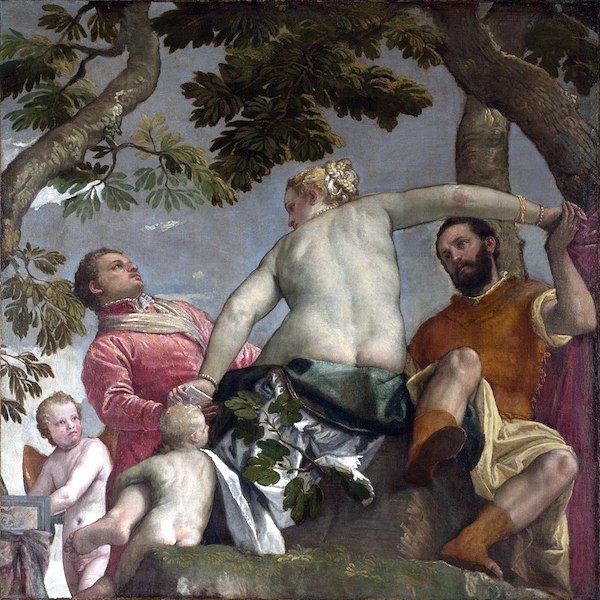
 LETHBRIDGE, ALBERTA Canada—(Weekly Hubris)—December 2017—This month, I turn a small, ephemeral item into a key opening a vast and knotted topic. The larger topic is love. The item is a brief note by the writer Katherine Mansfield, addressed to a “Princess Bibesco,” then involved in an affair with Mansfield’s husband, the author, editor and critic John Middleton Murry.
LETHBRIDGE, ALBERTA Canada—(Weekly Hubris)—December 2017—This month, I turn a small, ephemeral item into a key opening a vast and knotted topic. The larger topic is love. The item is a brief note by the writer Katherine Mansfield, addressed to a “Princess Bibesco,” then involved in an affair with Mansfield’s husband, the author, editor and critic John Middleton Murry.
Mansfield and Murry had a legendarily-complicated relationship, with infidelities on both sides. But what exasperated Mansfield in this instance was Bibesco’s sending a stream of love letters to Murry, some of which she must have intercepted.
Notes like this are now rare. Of course, aggrieved words over affairs are still traded but, typically, via text message or, more boldly, in social media posts. Though they still condemn rule-breaking, they now tend to follow epistolary conventions only loosely.
This note, however, is tightly controlled and deliberate. Here it is:
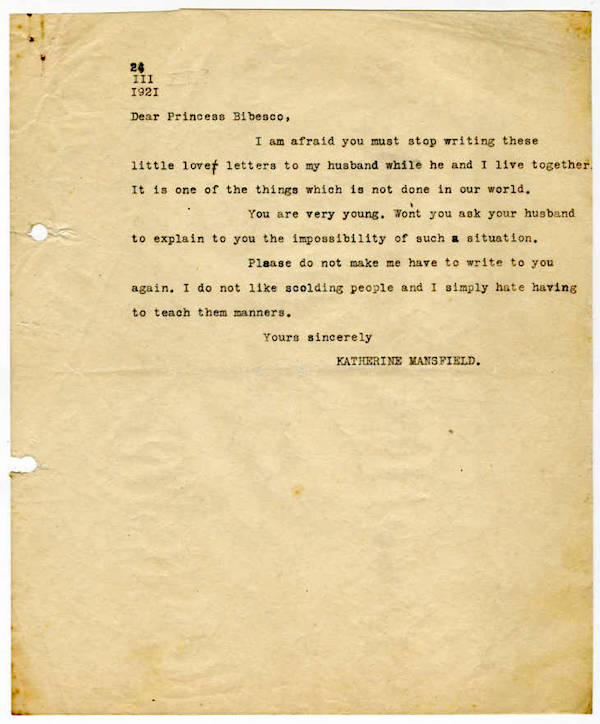
A masterpiece of concision and composition, this note is also an artifact of a lost culture formed at the intersection of American and English literati with European aristocracy, near the zenith of literary modernism now almost a century ago. It was written (then) in response to the possibility of personal loss, and is (now) an item saved in an archive but deemed interesting enough to post to social media, where I first saw it. It speaks to collecting and recollecting, to a writer’s personality, to a cultural moment, and to a seemingly universal dilemma.
Let’s start with its material and formal properties.
The note is typed, on a plain, un-monogrammed sheet of paper. At top left, a ghostly rust-image of a paper clip and perhaps also of push-through fasteners (common before staplers became ubiquitous) tells us it has been attached to other documents at some point. Two round holes on the left edge also show that it has been in a binder of a sort popular before the three-ring and 8 ½ X 11 or A4 paper-sizes became standard. It contains an interesting typo with a pencil stroke through it; an intervention predating the age of liquid paper and its ilk.
Clearly, before it entered the rust-free environs of a university archive, it had been kept in one or more collections of papers, starting with . . . whom? Bibesco? No. The plain paper, and perhaps the typo and lack of signature, indicate that it is a copy kept by Mansfield and, after her death, perhaps by Murry. (It would make for interesting speculation if Murry knowingly preserved it, though he may have done so simply out of professional scruples if he saw himself more as a curator of literary artifacts than a wayward husband.)
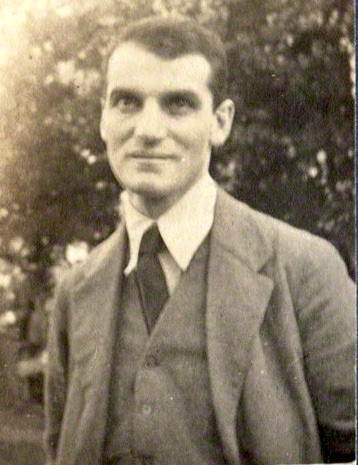
The note is dated in Latin numerals for the month, but Arabic numbers for the day and year. Paragraphs are indented in the early 20th-century manner, as is the closing salutation. It is unsigned, but Mansfield’s name is in all caps where a signature would be, followed by an emphatic period. The salutation begins with “Dear,” but then, as now, this indicates no necessary affection. That would have been communicated by “My Dear,” “Dearest,” or “Darling,” all usable for affectionate but non-romantic correspondence. Here, its effect is to distance. It signifies the sort of restrained disapproval exemplified by an editor politely severing a problematic author, or the kind of civil enmity communicated by an old-fashioned lawyer threatening a lawsuit.
What follows this distant “Dear” reinforces that impression of emotionless formality. “Princess Bibesco” is identified only by her rank and her husband’s surname. There is neither an honorific (e.g., “highness”) nor a first name; just a bare-bones (modernist!) identification of the receiver’s social location. But the terms of that location are chosen carefully. They indicate social rank and marital status because both will be weaponized in what comes next.
Why rank? On the face of it, Mansfield (who wasn’t of noble birth), is rebuking a social superior for violating an aristocratic etiquette governing liaisons. However, the mention of things not done “in our world” [my emphasis] introduces an ambiguity. Is this the social world of Mansfield and Murry? Or a world all three share? Mansfield’s faux-hesitant injunction, “I am afraid you must stop,” is delivered as if certain rules of politesse should be known by all the parties. She is elevating herself, and diminishing the princess, in more ways than one.
“Little love letters” is clearly a contemptuous diminutive, to which “these” is prepended dismissively. One might imagine Mansfield’s hand waving these fluttering trifles away. The qualifier “while he and I live together” obliquely acknowledges that affairs happen and that this one is in progress. The existence of the letters forces that acknowledgement. But Mansfield is also determined to grant them no force. Her mention of her cohabitation with Murry also serves as a reminder that liaisons are to be conducted with discretion. Mansfield writes as if from within the normative world of aristocracy, in which affairs are generally accepted but carried on with discernment and according to a suite of manners. Her admonition that “[i]t is one of the things which is not done in our world” delivers an implicit warning: this behavior could damage the reputation of the princess. Poor Bibesco: blind, impulsive naïf; so unaware, so much like a child, or . . . a parvenu.
And so to the next paragraph. “You are very young” dips with acid condescension, lightly disguised as a partial excuse for Bibesco’s crass behavior. There must, after all, be some reason for her childish inability to understand finesse. But then, the lethal stroke: “Won’t you ask your husband to explain to you . . .” This is more than an ironic jab at the cuckolded prince, or a threat. “Husband,” here, stands in for “daddy.”
The schoolmarmish concluding paragraph is necessary mainly to bring the note to an end, but it reinforces once more the image of Bibesco as an undisciplined and embarrassing child. Don’t make me say no again. I don’t want to send you to your room. Claire Tomalin, Mansfield’s biographer, remarked on her “queenly” tone here, suggesting that she was channeling her mother’s voice in chastising Bibesco.
In a very few lines, Mansfield’s note manages to give a pen portrait of the princess that is clearly recognizable then and now as a type (even, and especially, if we do not know of her), and also a nuanced view of her world. Bibesco is immature, brainless, and déclassé, unworthy of a sophisticated woman’s consideration. Mansfield conveys this in a charade of considerate advice; a simulacrum of care. For our purposes, as well as Mansfield’s, it matters not what was in Bibesco’s heart, nor who she was as a multidimensional person. She has been bad and has soiled the rug.
There are additional dimensions to consider but, first, let’s examine the dramatis personae identified in this deceptively simple piece of material and literary culture.
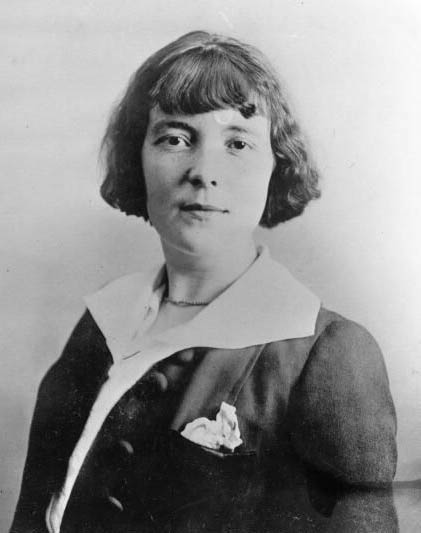
Katherine Mansfield is deemed one of the most important of modern short-story writers. She was born in New Zealand in 1888, to a wealthy and socially-connected family, and was sent to London for schooling in her teens. There, she learned languages and began writing. Her return to New Zealand was unhappy, and she conspired with a friend to leave again. She never returned. She led a relationally and sexually reckless existence in England and in Europe prior to marrying John Middleton Murry, the husband in the abovementioned note. They stayed together a number of years, but both had affairs during that time. Mansfield and Murry were acquainted with members of the Bloomsbury circle, as well as D. H. Lawrence and Frieda von Richthofen, and Mansfield had a tense friendship with Virginia Woolf, who deeply admired but was also jealous of her literary ability. Often in ill health and alone in her final years, she died in 1923 of complications from tuberculosis. Her final words were, “I love the rain. I want the feeling of it on my face.”
“Princess Bibesco” was Elizabeth Charlotte Lucy Asquith (1897-1945), nine years younger than Katherine (23 when she began her affair with Murry; Mansfield was then 32). This age gap—significant, but far from immense—adds a certain irony to Mansfield’s characterization of her as “very young.”
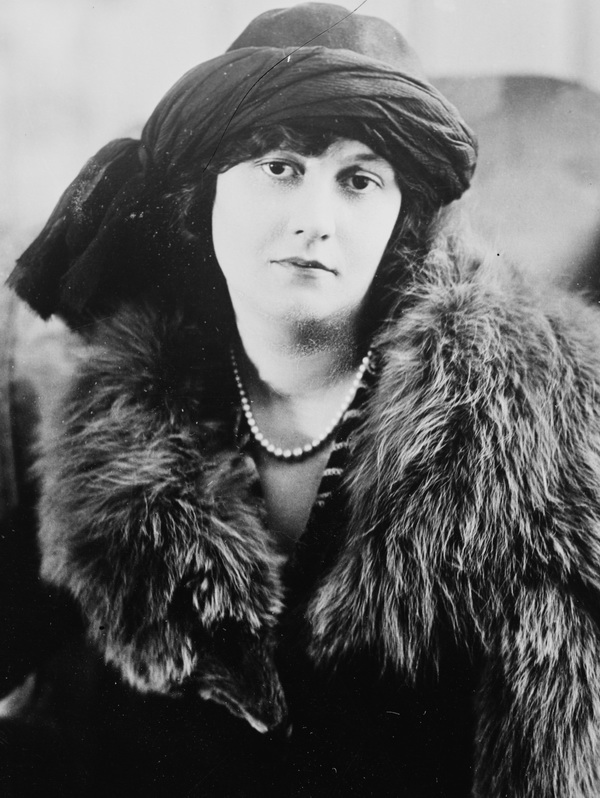
Elizabeth Bibesco was English, the daughter of the wartime British Prime Minister, Lord Asquith, who came a middle-class background but was raised to the peerage late in his life. Like Mansfield, Elizabeth was a precocious writer, producing short stories, sketches, novels, and poetry. She married Prince Antoine Bibesco, a Romanian diplomat 22 years her senior, a close friend of Marcel Proust, whom she also befriended. They lived in Paris, Washington, and Madrid. She died in Romania in 1945, and her husband was exiled soon after.
Bibesco’s oeuvre is far less well-known today than Mansfield’s, though it still attracts some literary and academic attention. The settings of her fiction are often aristocratic, but she betrays a transgressive spirit: Elizabeth Bowen, editor of a posthumous collection of her short stories, wrote that “[t]he Bibesco characters seem to be the inhabitants of a special milieu, in which the more ordinary taboos of feeling and brakes on speech do not operate.”
A case could be made, then, that Mansfield and the princess were both romantic and literary rivals, though Bibesco’s work was never as acclaimed. There may also have been a class and birthplace-status rivalry. Elizabeth Bibesco was born English, whereas Mansfield was from the colonies and, despite the similar middle-class class origins of their respective families, this may have rankled. (When I visited Oxford for a conference in the 1990’s, an English fellow-attendee, on hearing my accent and inquiring, still took the trouble to make a point of my “colonial” status.) Prince Bibesco’s title would likely have received a certain discount in Anglo circles because of its country of origin, but it was valid. Elizabeth had married well above her station, and Mansfield hadn’t.
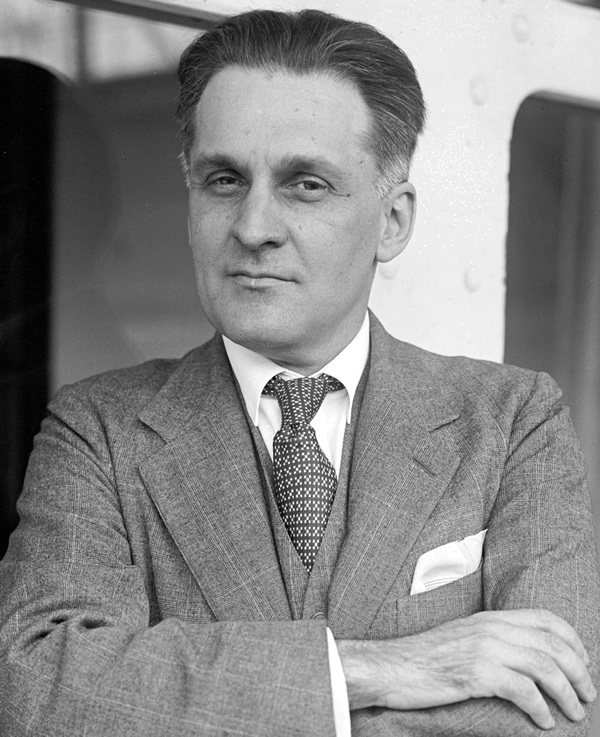
But one can read a different voice, however muted, into the note that hints at these rivalries; that of a woman wounded, angry, and lost at the realization that her husband’s affections had turned toward someone less worthy, though of a higher rank. If she fell at all into a state of depressive rumination (and she was, by all accounts, emotionally labile), she could have interpreted that development to communicate something negative both about the husband she had chosen and about herself and her own worth. While Murry received love letters from a putative idiot, she was in danger of losing that part of her identity, emotional stability, and security that rested in romantic or marital love. She had been betrayed but, worse, she had been shown to be unworthy of discretion, and she was in danger of being left broken, abandoned. That voice of vulnerability could not appear on the page. Potentially, an icy reserve could become the only armor remaining to her. She had to appear dignified, and to contrast that appearance to the indignity of the other’s indiscretions.
To sense the hurt underlying the cold anger governing the note’s affect-free formality is to allow it to signify something universal beyond the particulars of cultural or literary history, if one believes that sexual and romantic jealousy are universal. We have Shakespeare, the roistering novels of the 18th century, and the romantic poets of the 19th, in part, to thank for that belief.
But wait. Is it possibly a little tendentious to reduce Mansfield’s evisceration of Bibesco to a substratum of “feelings” and vulnerabilities; to make her out to be morally wronged in a manner suitable for reproduction in social-media memes? Janet Wilson and Gerri Kimber would say it is. In Katherine Mansfield and the (Post)colonial, they treat the note to Bibesco as an artifact of literary performance. That makes sense as a working hypothesis, given that Mansfield was a writer fully cognizant of the literature produced by her contemporaries and predecessors. Wilson and Kimber also point out that Mansfield had given her husband explicit permission for the affair, writing to him the previous December, “[D]o feel free; I mean that.”
What, then, might have changed her mind? Wilson and Kimber argue that the clue may lie in Mansfield’s familiarity with the work of Edith Wharton; in particular, Wharton’s novel of adultery, set in aristocratic world of New York’s Gilded Age first families, The Age of Innocence. They claim that “[t]he love triangle described by Wharton was in fact replicated in Mansfield’s own life . . . Indeed, the chain of events that follow [her discovery of Murry’s affair with Bibesco] enacts a parodic reiteration of the plot of The Age of Innocence—a reiteration . . . either knowingly or unconsciously prompted by her reading of Wharton’s novel around the same time.” They flesh out this claim by identifying wording and structural features in the note that parallel those in Mansfield’s own review of The Age of Innocence.
These parallels, they argue, are not unconscious, but illustrate an “extension of Mansfield’s performative bent as well as her performative versatility and unwillingness to confine herself to a single register or subject-position.” Of course, the performance also has a purpose, and it does express something, but Wilson and Kimber assert that “it is less the adultery to which Mansfield objects than the inability of the ‘young’ Bibesco, in carrying out her ‘little’ intrigue, to fulfil, in all its delicate complexity, the role [of] the alluring other woman in the grand manner . . . .” They go so far as to suggest that Mansfield was attracted both to the “rebelliousness” of Ellen Olenska, the other woman of Wharton’s novel, and to what she herself called Olenska’s “highly civilized appreciation of the exquisite difficulty of their position.” In short, this is a Mansfield envious of her real-life “Ellen”; drawn to Bibesco’s transgressiveness, but disappointed by her inability to know when or how to rein it in. Perhaps Mansfield is also drawing closer to the tubercular pathos of Lawrence, though holding slightly different allegiances in the wars between disintegrating convention and the forces of sex.
Mansfield’s note thus speaks of more than the universal love triangle. It also sounds out from the now-silent world of the early 20s in Europe and urban America; one in which moral, class and artistic certainties had been shattered by war, though they were still clung to by churchmen and the old families, and brandished by their political gatekeepers. But the modernist rebelliat of writers, artists and bohemians did not simply reject such broken verities. They were just as likely to re-work the fragments, in surprising ways, into experimental domestic and sexual arrangements, alternative aesthetic and political philosophies, and new forms of literary and performative expression which may have extended even to this ephemeral note of complaint.
There are worlds upon worlds, then, latent in this one brief note. That made me curious about how present-day readers might see it. At the last minute (my submission deadline having already passed), I posted it to Facebook and managed to get a handful of interestingly diverse responses. I give them below, in order of the submitters’ ages, from youngest to oldest. The first two are at a generation’s remove from the latter two. All are women; no men responded in time for publication (!).
From a research laboratory employee and community activist:
“Haha, well that was certainly passive aggressive! My imagination is full of ideas on the back story . . . who, when, where, why . . . it’s interesting to try to fill in the blanks on the series of events that led to such a letter!”
From a sociologist and college professor:
“So condescending! ‘You are very young. Won’t you let your husband explain . . .’ Wow! Because youth and gender make a massive impact on perspective in this case. I also find it interesting that it wasn’t drawn to attention that perhaps her husband would take issue with it, just that the situation is impossible.”
From a professor of art history:
“Mansfield is a writer, and her ambiguity [around the injunction] that the princess must not write ‘while he and I live together’—like it’s OK when they don’t live together— seems quite precise.”
From a humanities professor and artist:
“I am pleased that a mature woman realizes that is power rather than abject apology.”
Perhaps, Dear Reader, you will find yourself reacting in similar or dissimilar ways to Mansfield’s note, or to my academic parsing of it. Perhaps another picture of the situation it refers to will come to your mind. Perhaps you have a response to the four Facebook responses above. If so, let me reveal an agenda.
If I can bridle my writing self to trot with enough persistence in one particular direction, I’d like to write a series about love in its various dimensions, intensities, and types. I don’t want to discuss love only as a putative universal. I want to tell stories that situate it concretely, in times, spaces, societies, classes, genders and sexual codes. I’d like to explore conflicts, forms of exploitation and altruism, customs and innovations, ideas, bodily configurations, and even technologies.
If you feel so moved, do use the comments section to tell me what you think I should attend to as I explore this terrain.
![]()
References:
“. . . indicate a typed (or carbon) copy . . .”
Confirmed by the online finding aid; see http://norman.hrc.utexas.edu/fasearch/findingAid.cfm?eadid=00959
“. . . and after her death, perhaps by Murry. . .”
The online finding aid indicates that a significant amount of Mansfield material in the archives was collected from “close associates of Mansfield” by her biographer, Ruth Elvish Shantz, and donated by her. For more on Murry, see http://www.modjourn.org/render.php?view=mjp_object&id=mjp.2005.01.026
“Claire Tomalin, a biographer of Mansfield . . .”
Claire Tomalin, Katherine Mansfield: A Secret Life (New York: Viking, 1987), as noted in Janet Wilson and Gerri Kimber, Katherine Mansfield and the (Post)colonial (Edinburgh: University of Edinburgh Press, 2013), p. 97.
“Katherine Mansfield is deemed to be . . .”
I have drawn heavily here on a pocket biography of Mansfield by Joanna Fitzpatrick, “In Pursuit: The Katherine Mansfield Story,” History and Women, September 25, 2011: http://www.historyandwomen.com/2011/09/in-pursuit-katherine-mansfield-story-by.html
“Her last words were . . .”
Joanna Fitzpatrick, “In Pursuit: The Katherine Mansfield Story,” History and Women, September 25, 2011: http://www.historyandwomen.com/2011/09/in-pursuit-katherine-mansfield-story-by.html
“Elizabeth Bibesco was English . . .”
For more on Elizabeth Asquith Bibesco, see https://en.wikipedia.org/wiki/Elizabeth_Bibesco
A film clip of a slightly pouty Elizabeth at her 1919 wedding can be seen near the end of this YouTube clip: https://www.youtube.com/watch?v=VUQWdLrQ77U
And a lively obituary of Elizabeth and Antoine’s daughter Priscilla, born the year her mother began an affair with Murry, can be found here: http://www.independent.co.uk/news/obituaries/priscilla-bibesco-534719.html
“She married Prince Antoine Bibesco . . .”
For more on Antoine Bibesco, see https://en.wikipedia.org/wiki/Antoine_Bibesco and http://www.romanianculture.org/personalities/Antoine_Bibesco.htm
“Elizabeth Bowen, editor of a posthumous collection of her short stories . . .”
Elizabeth Bowen, “Foreword to Haven,” in Bowen, People, Places, Things – Essays by Elizabeth Bowen, ed. A. Hepburn (Edinburgh: Edinburgh University Press, 2008), p. 255.
“Janet Wilson and Gerri Kimber would say it is . . .”
Janet Wilson and Gerri Kimber, Katherine Mansfield and the (Post)colonial (Edinburgh: University of Edinburgh Press, 2013). The material quoted from or attributed to Wilson and Kimber appears on pp. 95-98.
About the Illustrations:
Image 1
Paolo Veronese (1528–1588), Allegory of Love I: Unfaithfulness (circa 1575). National Gallery, London. Public domain. See https://commons.wikimedia.org/wiki/File:Paolo_Veronese_020.jpg
Image 2
Letter from Katherine Mansfield to Princess Elizabeth Asquith Bibesco, Katherine Mansfield Collection, Harry Ransom Center, The University of Texas at Austin. Public domain. See https://hrc.contentdm.oclc.org/digital/collection/p15878coll47/id/988
Image 3
Snapshot of John Middleton Murry, taken 1917 by Ottoline Morrell. National Portrait Gallery, via Wikimedia Commons. Public domain. See https://commons.wikimedia.org/wiki/File:John_Middleton_Murry,_1917.jpg
Image 4
Katherine Mansfield, 1912. From Wikimedia Commons. Public domain. See https://commons.wikimedia.org/wiki/File:Mansfield1.jpg
Image 5
Elizabeth Asquith Bibesco, 1919. Library of Congress, via Wikipedia. Public domain. See https://commons.wikimedia.org/wiki/File:Elizabeth_Bibesco.jpg
Image 6
Prince Antoine Bibesco. George Grantham Bain Collection, Library of Congress, via Wikipedia. Public domain. See https://commons.wikimedia.org/wiki/File:Antoine_Bibesco.jpg
